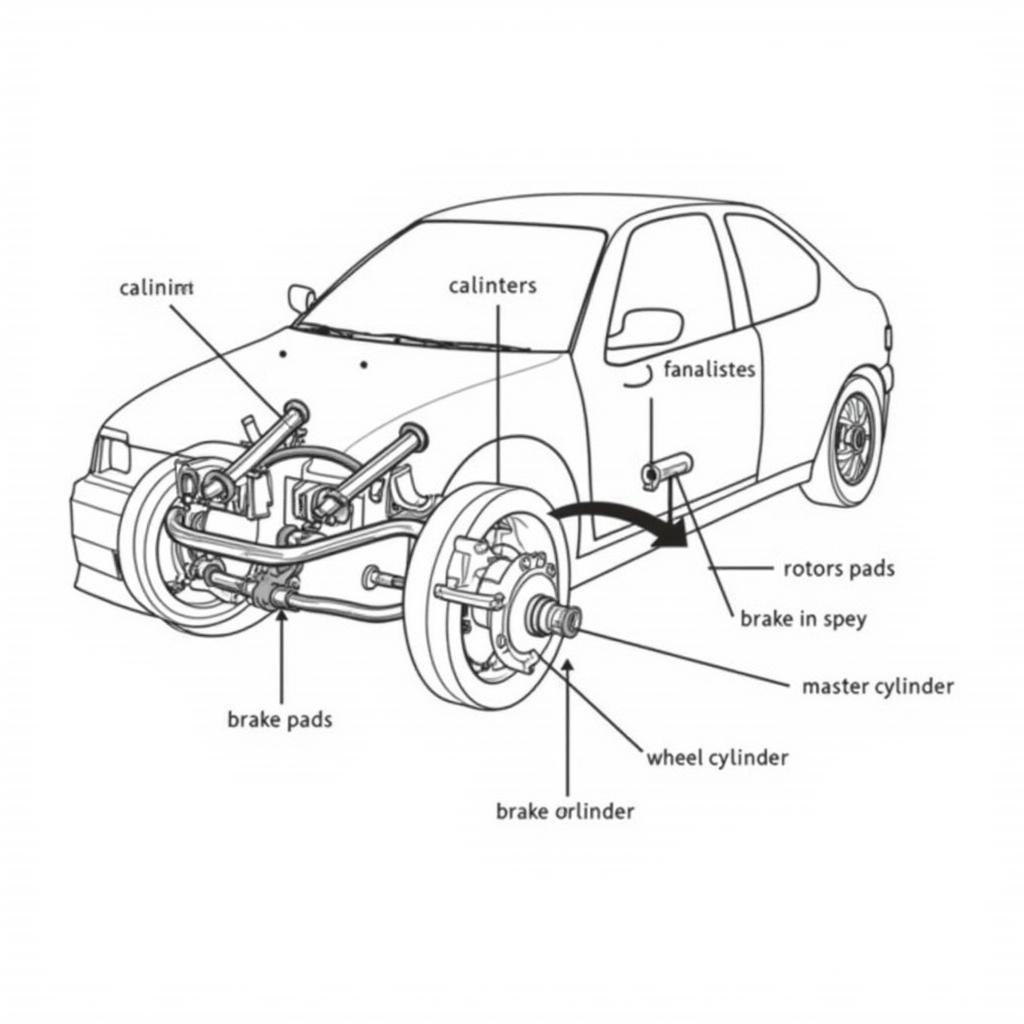The red brake warning light on your dashboard is a crucial safety indicator. It’s designed to grab your attention and warn you of a potential problem with your vehicle’s braking system. Ignoring this warning light could be dangerous, leading to reduced braking performance or even complete brake failure. This comprehensive guide will delve into the common causes of a red brake warning light, how to diagnose the issue, and the potential solutions to get you back on the road safely.
Understanding Your Vehicle’s Braking System
Before we dive into the causes and solutions, it’s helpful to understand the basics of how your car’s braking system works. Modern vehicles typically utilize a hydraulic system that relies on brake fluid to transmit force from the brake pedal to the wheels.
 Car brake system components diagram
Car brake system components diagram
When you press the brake pedal, it activates the master cylinder, which pressurizes the brake fluid. This pressurized fluid travels through brake lines to calipers on each wheel. The calipers then squeeze brake pads against rotors (or drums in some cases), creating friction that slows down the vehicle.
Common Causes of a Red Brake Warning Light
A red brake warning light can illuminate for several reasons, ranging from simple issues to more complex problems. Here are some of the most common culprits:
1. Low Brake Fluid Level
One of the most frequent reasons for the red brake warning light is a low brake fluid level. As brake pads wear down, the brake fluid level in the master cylinder naturally decreases. If the fluid level drops too low, it can trigger the warning light.
Solution: Check your brake fluid reservoir. If the level is low, add the recommended brake fluid for your vehicle model. However, simply adding fluid might not be enough if you suspect a leak.
 A person checking the brake fluid level in a vehicle
A person checking the brake fluid level in a vehicle
2. Worn Brake Pads
Brake pads are designed to wear down over time. When they reach a certain level of wear, a sensor in the brake pad will trigger the warning light to indicate it’s time for a replacement.
Solution: If your brake pads are worn, they will need to be replaced. It’s generally recommended to replace both the pads and rotors together for optimal braking performance.
3. Brake Fluid Leak
A leak in the brake system can lead to a loss of brake fluid pressure, compromising your ability to stop the vehicle safely. Leaks can occur in the brake lines, hoses, calipers, or wheel cylinders.
Solution: A brake fluid leak requires immediate attention. Have your vehicle inspected by a qualified mechanic to identify and repair the leak.
4. Faulty Brake Light Switch
The brake light switch is responsible for activating your brake lights when you press the brake pedal. In some vehicles, this switch is also connected to the brake warning light system. If the switch malfunctions, it can illuminate the warning light.
Solution: A faulty brake light switch will need to be replaced.
5. ABS Issue
Modern vehicles are equipped with an Anti-lock Braking System (ABS) that prevents wheels from locking up during hard braking. If the ABS system detects a problem, it can trigger the red brake warning light.
Solution: Diagnosing an ABS issue typically requires specialized diagnostic equipment. It’s best to consult with a qualified mechanic or dealership for diagnosis and repair.
What to Do When the Red Brake Warning Light Comes On
- Don’t Panic: While the red brake warning light is a serious signal, it’s essential to remain calm.
- Safely Pull Over: As soon as it’s safe, slowly pull over to the side of the road and come to a complete stop.
- Check Brake Fluid Level: Carefully open the hood and check the brake fluid level in the reservoir. If it’s low, add fluid if you have some available.
- Assess the Situation: If adding brake fluid doesn’t resolve the issue, or you notice other symptoms like a spongy brake pedal or unusual noises, it’s best to err on the side of caution.
- Call for Assistance: Avoid driving further and call for roadside assistance or a tow truck to transport your vehicle to a trusted mechanic or dealership.
 A car pulled over to the side of the road with its hood open
A car pulled over to the side of the road with its hood open
Preventing Brake Problems
Regular maintenance is key to preventing brake problems and ensuring optimal safety:
- Regular Inspections: Have your brakes inspected at least once a year or as recommended in your vehicle’s owner’s manual.
- Timely Brake Pad Replacement: Replace your brake pads before they wear down completely.
- Brake Fluid Flush: Have your brake fluid flushed and replaced every 2-3 years or as recommended by your manufacturer.
- Address Issues Promptly: If you experience any brake-related issues, such as a soft brake pedal, unusual noises, or vibrations, don’t delay in getting your vehicle checked by a professional.
Expert Insight
“Many drivers underestimate the importance of regular brake maintenance,” says John Smith, a certified automotive technician with over 20 years of experience. “Ignoring the red brake warning light or delaying brake repairs can lead to costly repairs down the line and, more importantly, compromise your safety on the road.”
Conclusion
The red brake warning light is a critical safety indicator that should never be ignored. Understanding its potential causes and taking prompt action can help you address brake problems early, ensuring your safety and the optimal performance of your vehicle. Remember, regular maintenance and timely repairs are essential for a safe and enjoyable driving experience.
FAQs
1. Can I drive with the red brake warning light on?
It’s highly discouraged to drive with the red brake warning light illuminated. Doing so could be dangerous and lead to further damage to your braking system.
2. How much does it cost to fix a red brake warning light?
The cost of repair can vary significantly depending on the underlying cause. Simple fixes like adding brake fluid or replacing a brake light switch can be relatively inexpensive. However, more complex issues like brake line replacements or ABS repairs can be more costly.
3. How often should I check my brake fluid level?
It’s a good practice to check your brake fluid level at least once a month and more frequently if you notice any changes in your brake pedal feel.
4. Can I add any brake fluid to my car?
No, it’s crucial to use the recommended brake fluid type specified in your vehicle’s owner’s manual. Using the wrong type of fluid can damage your braking system.
5. How long can I drive with worn brake pads?
Driving with worn brake pads is unsafe and can damage your rotors. It’s crucial to replace your brake pads as soon as they reach their minimum thickness level.
6. What is the difference between the red and yellow brake warning lights?
The red brake warning light typically indicates a serious issue requiring immediate attention, while a yellow brake warning light might signal an issue with the ABS system or electronic parking brake.
7. Can I fix my brakes myself?
While some brake maintenance tasks, like adding brake fluid, can be done by car owners with some mechanical skills, it’s generally recommended to have brake repairs and more complex diagnostics performed by qualified mechanics.
This article provides general information and should not be considered a substitute for professional advice. Always consult with a qualified mechanic for any brake-related concerns or repairs.

